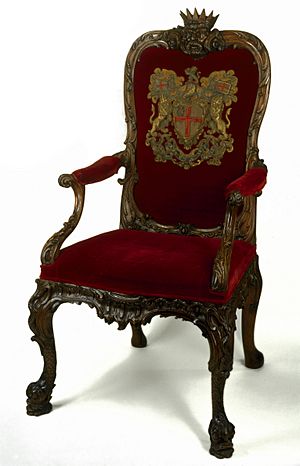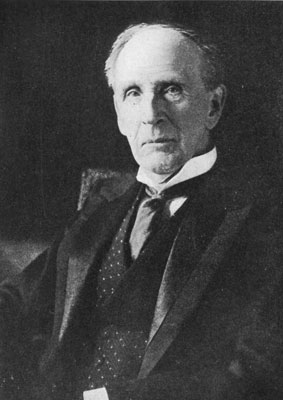Secretary of State for India facts for kids
Quick facts for kids Secretary of State for India |
|
|---|---|

Royal Arms as used by His Majesty's Government
|
|
| India Office | |
| Member of | British Cabinet Privy Council |
| Seat | Westminster, London |
| Appointer | The British Monarch on advice of the Prime Minister |
| Term length | No fixed term |
| Constituting instrument | Government of India Act |
| Precursor | President of the Board of Control |
| Formation | 2 August 1858 |
| First holder | Lord Stanley |
| Final holder | The 5th Earl of Listowel |
| Abolished | 14 August 1947 |
| Deputy | Under-Secretary of State for India |


The Secretary of State for India was a very important job in the British government. This person was a Cabinet minister and the main political leader of the India Office. Their job was to manage the British rule in India, Aden, and Burma.
This position was created in 1858. Before that, a company called the East India Company ruled parts of India. But after 1858, the British government in Whitehall (London) took direct control of India. This marked the start of the official colonial period under the British Empire.
In 1937, the India Office was changed. Burma and Aden got their own new department called the Burma Office. However, the same Secretary of State was in charge of both departments. So, the job title became His Majesty's Principal Secretary of State for India and Burma.
The India Office and the Secretary of State job ended on August 14, 1947. This happened when the United Kingdom gave independence to India and Pakistan through the Indian Independence Act 1947. Burma became independent shortly after, in early 1948.
Contents
Leaders for India: 1858–1937
This table shows the people who held the job of Secretary of State for India. Before this job was created in 1858, Lord Stanley was in charge of the Board of Control, which also managed India.
| Picture | Name | Time in Office | Political Party | Prime Minister | |||
|---|---|---|---|---|---|---|---|
 |
Lord Stanley MP for King's Lynn |
2 August 1858 |
11 June 1859 |
Conservative | The 14th Earl of Derby | ||
 |
Sir Charles Wood MP for Halifax until 1865 MP for Ripon after 1865 |
18 June 1859 |
16 February 1866 |
Liberal | Viscount Palmerston | ||
| The Earl Russell | |||||||
 |
The Earl de Grey | 16 February 1866 |
26 June 1866 |
Liberal | |||
 |
Viscount Cranborne MP for Stamford |
6 July 1866 |
8 March 1867 |
Conservative | The 14th Earl of Derby | ||
 |
Sir Stafford Northcote MP for North Devonshire |
8 March 1867 |
1 December 1868 |
Conservative | |||
| Benjamin Disraeli | |||||||
 |
The Duke of Argyll | 9 December 1868 |
17 February 1874 |
Liberal | William Ewart Gladstone | ||
 |
The Marquess of Salisbury | 21 February 1874 |
2 April 1878 |
Conservative | Benjamin Disraeli | ||
 |
The Viscount Cranbrook | 2 April 1878 |
21 April 1880 |
Conservative | |||
 |
Marquess of Hartington MP for North East Lancashire |
28 April 1880 |
16 December 1882 |
Liberal | William Ewart Gladstone | ||
 |
The Earl of Kimberley | 16 December 1882 |
9 June 1885 |
Liberal | |||
 |
Lord Randolph Churchill MP for Paddington South |
24 June 1885 |
28 January 1886 |
Conservative | The Marquess of Salisbury | ||
 |
The Earl of Kimberley | 6 February 1886 |
20 July 1886 |
Liberal | William Ewart Gladstone | ||
 |
The Viscount Cross | 3 August 1886 |
11 August 1892 |
Conservative | The Marquess of Salisbury | ||
 |
The Earl of Kimberley | 18 August 1892 |
10 March 1894 |
Liberal | William Ewart Gladstone | ||
 |
Henry Fowler MP for Wolverhampton East |
10 March 1894 |
21 June 1895 |
Liberal | The Earl of Rosebery | ||
 |
Lord George Hamilton MP for Ealing |
4 July 1895 |
9 October 1903 |
Conservative | The Marquess of Salisbury (Unionist Coalition) |
||
| Arthur Balfour (Unionist Coalition) |
|||||||
 |
William St John Brodrick MP for Guildford |
9 October 1903 |
4 December 1905 |
Irish Unionist | |||
 |
John Morley MP for Montrose Burghs until 1908 Viscount Morley of Blackburn after 1908 |
10 December 1905 |
3 November 1910 |
Liberal | Sir Henry Campbell-Bannerman | ||
| H. H. Asquith | |||||||
 |
The Earl of Crewe | 3 November 1910 |
7 March 1911 |
Liberal | |||
 |
The Viscount Morley of Blackburn | 7 March 1911 |
25 May 1911 |
Liberal | |||
 |
The Marquess of Crewe | 25 May 1911 |
25 May 1915 |
Liberal | |||
 |
Austen Chamberlain MP for Birmingham West |
25 May 1915 |
17 July 1917 |
Conservative | H. H. Asquith (Coalition) |
||
 |
Edwin Montagu MP for Chesterton until 1918 MP for Cambridgeshire after 1918 |
17 July 1917 |
19 March 1922 |
Liberal | |||
 |
The Viscount Peel | 19 March 1922 |
22 January 1924 |
Conservative | Bonar Law | ||
| Stanley Baldwin | |||||||
 |
The Lord Olivier | 22 January 1924 |
3 November 1924 |
Labour | Ramsay MacDonald | ||
 |
The Earl of Birkenhead | 6 November 1924 |
18 October 1928 |
Conservative | Stanley Baldwin | ||
 |
The Viscount Peel | 18 October 1928 |
4 June 1929 |
Conservative | |||
 |
William Wedgwood Benn MP for Aberdeen North |
7 June 1929 |
24 August 1931 |
Labour | Ramsay MacDonald | ||
 |
Sir Samuel Hoare MP for Chelsea |
25 August 1931 |
7 June 1935 |
Conservative | Ramsay MacDonald (1st & 2nd National Min.) |
||
 |
The Marquess of Zetland | 7 June 1935 |
28 May 1937 |
Conservative | Stanley Baldwin (3rd National Min.) |
||
Leaders for India and Burma: 1937–1947
After 1937, the Secretary of State was in charge of both India and Burma.
| Picture | Name | Time in Office | Political Party | Prime Minister | |||
|---|---|---|---|---|---|---|---|
 |
The Marquess of Zetland | 28 May 1937 |
13 May 1940 |
Conservative | Neville Chamberlain (4th National Min.; War Coalition) |
||
 |
Leo Amery MP for Birmingham Sparkbrook |
13 May 1940 |
26 July 1945 |
Conservative | Winston Churchill (War Coalition; Caretaker Min.) |
||
 |
The Lord Pethick-Lawrence | 3 August 1945 |
17 April 1947 |
Labour | Clement Attlee | ||
 |
The Earl of Listowel | 17 April 1947 |
14 August 1947 |
Labour | |||
Leaders for Burma: 1947–1948
After India gained independence, a separate Secretary of State for Burma was in charge for a short time until Burma also became independent.
| Picture | Name | Time in Office | Political Party | Prime Minister | |||
|---|---|---|---|---|---|---|---|
 |
The Earl of Listowel | 14 August 1947 |
4 January 1948 |
Labour | Clement Attlee | ||
Related Topics
- India Office
- British Raj
- British rule in Burma
- Governor-General of India
- Imperial Civil Service
- Government of India Act
| Northern Department 1660–1782 Secretaries Undersecretaries |
Foreign Office 1782–1968 Secretaries Ministers Undersecretaries |
Foreign and Commonwealth Office 1968–2020 Foreign, Commonwealth and Development Office since 2020 Secretaries Ministers Undersecretaries |
|||||||
| Southern Department 1660–1768 Secretaries Undersecretaries |
Colonial Office 1768–1782 Secretaries Undersecretaries |
Home Office 1782–1794 Secretaries Undersecretaries |
War Office 1794–1801 Secretaries Undersecretaries |
War and Colonial Office 1801–1854 Secretaries Undersecretaries |
Colonial Office 1854–1925 Secretaries Undersecretaries |
Colonial Office 1925–1966 Secretaries Ministers Undersecretaries |
Commonwealth Office 1966–1968 Secretaries Ministers Undersecretaries |
||
| Southern Department 1768–1782 Secretaries Undersecretaries |
Dominions Office 1925–1947 Secretaries Undersecretaries |
Commonwealth Relations Office 1947–1966 Secretaries Ministers Undersecretaries |
|||||||
| . | India Office 1858–1937 Secretaries Undersecretaries |
India Office and Burma Office 1937–1947 Secretaries Undersecretaries |
|||||||

